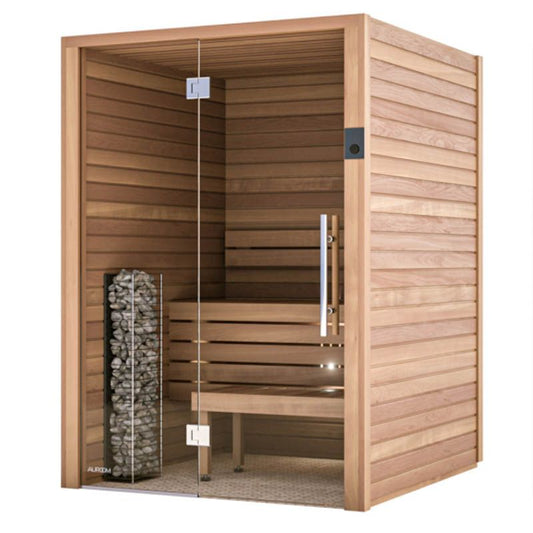An Unbiased View of Traditional Sauna
Wiki Article
Traditional Sauna Fundamentals Explained
Table of ContentsGetting My Traditional Sauna To WorkThe Definitive Guide for Traditional SaunaTraditional Sauna for BeginnersThe smart Trick of Traditional Sauna That Nobody is Discussing
A lot of the weight lost in a sauna is water loss and is re-gained upon rehydrating. Without a doubt sauna can be a vital component of a healthy weight loss program. To look at the distinctions between conventional and IR saunas, I will separate these right into verifiable, theoretical, and fabricated distinctions.Thus, the hottest factor in the saunawhich goes to the ceiling straight over the sauna heateris commonly between 185 and 190 F. Traditional Sauna. Claims that a typical sauna goes beyond 200 F is merely not true and not applicable for electrical saunas marketed in the United States. The temperature for a far-infrared sauna is typically set in between 120 and 140 F; nonetheless, unlike the traditional sauna, the objective in and IR area is not to attain a heat
As a result of this, the temperature difference is virtually irrelevant, considering that extreme sweating results in both sauna kinds, yet the approach of heating the body is various. In an IR sauna the bather will certainly really feel hot and will certainly sweat profusely, but at much lower temperatures. Thus, if the goal is to spend longer time periods in the sauna, the IR sauna is a good choice.

The Ultimate Guide To Traditional Sauna
When the high temperature level is accomplished, the components cycle on and off to maintain the high temperature level. A lot of conventional sauna users enjoy putting water over the rocks to develop steam to elevate sauna humidity levels. The benefits of pouring water over the rocks include: making the area much more comfortable, moistening the nasal flows, and permitting the usage of aromatherapy by blending essential oils with the water.In a far-infrared sauna, the warm front penetrate the body to properly warm the body and raise the body core temperature. To accomplish this boosted temperature, Far-infrared emitters create infrared energy which is close to the exact same wavelength as that which the body naturally emitsoften referred to as the "Essential Array" of 7 to 14 microns), so the power is well received by the body.
When the energy enters the body, it creates the body temperature level to boost and eventually causes perspiration. In an infrared sauna it is necessary for the emitters/heaters to stay on almost constantly. Given that there is no mass of rocks to preserve heat, the sauna will certainly cool down if the emitters shut off.
As mentioned above, the sauna bather in an infrared space desires to place himself before operating emitters to get maximum advantage from the warm. The heating time for the two areas can be extremely different, depending on just how the spaces are used. For a typical sauna, a bather must allow 30-40 minutes for the room to attain website link a wanted temperature level and to properly pre-heat the rocks.
The 5-Second Trick For Traditional Sauna
A well created sauna will normally attain a temperature of 150-160 F in regarding 30-40 minutes. For hotter temperature levels, the area may need to warmth for a longer duration.To some, 15 minutes was "thrown away" while the infrared power heated the wood panels rather than heating up a body, while others locate a pre-heated area to be extra comfortable and believe an elevated starting temperature is needed to start sweating. The size of advised usage for each and every area is roughly the exact same (10-15 mins per session); nevertheless, as a result of the reduced air temperature levels and the capacity to really feel the impacts of infrared warm quicker than a typical sauna, it is not unusual for an individual to invest a total amount of 20-30 mins in an infrared sauna.
Traditional saunas have a tendency to be larger (therefore make use of even more electrical energy) than infrared saunas, although standard saunas are certainly available in one and two individual dimensions too. For a two-person standard sauna, 5x6 or 5x7 dimension is most prominent. The leading bench can easily seat two or 3 individuals and is additionally long sufficient to exist down throughout the sauna session.


The typical expense per kWH of electricity in the united state is approximately $0.11, so a 4.5 kW heating unit will cost about $.50 to run for one hour, if the heating system runs continuously for one hour. Typically a sauna heating unit will certainly run for 75% of the initial hour and 50% of subsequent hours on considering that the elements cycle once the set temperature level is achieved.
Rumored Buzz on Traditional Sauna
A two individual far-infrared area is usually physically smaller than a typical sauna, frequently regarding 4' x 4' or smaller. The IR heater is commonly 1.5-1.7 kW using a 120 volt 15 amp plug-in service. Because the area can be used sooner than a sauna room, we will presume the space is used for to of an hour including warm up time.There is a hardly ever reviewed distinction in the social experience between the 2 areas. While our culture has lost a few of the social site here benefit of the traditional sauna experience, it can be very socially gratifying. From family time in the sauna, to heart-felt conversations with loved ones, to sauna partiesthe standard sauna experience can result in intimate socializing.
Many higher end infrared visit this site right here areas consist of colored light treatment, sound systems and full-glass fronts.
Report this wiki page